

Www.dol.gov/whd/regs/compliance/whdfs12.pdf. Report highlights child labor on US tobacco farms. RICHMOND, Va.
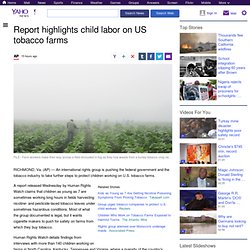
(AP) — An international rights group is pushing the federal government and the tobacco industry to take further steps to protect children working on U.S. tobacco farms. A report released Wednesday by Human Rights Watch claims that children as young as 7 are sometimes working long hours in fields harvesting nicotine- and pesticide-laced tobacco leaves under sometimes hazardous conditions. Most of what the group documented is legal, but it wants cigarette makers to push for safety on farms from which they buy tobacco. Human Rights Watch details findings from interviews with more than 140 children working on farms in North Carolina, Kentucky, Tennessee and Virginia, where a majority of the country's tobacco is grown.
"The U.S. has failed America's families by not meaningfully protecting child farmworkers from dangers to their health and safety, including on tobacco farms," said Margaret Wurth, children's rights researcher and co-author of the report. Gapminder: Unveiling the beauty of statistics for a fact based world view. New report details racial gap among US children. NEW YORK (AP) — In every region of America, white and Asian children are far better positioned for success than black, Latino and American Indian children, according to a new report appealing for urgent action to bridge this racial gap.
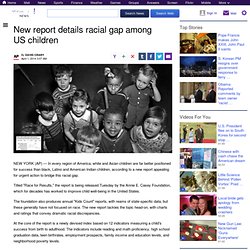
Titled "Race for Results," the report is being released Tuesday by the Annie E. Casey Foundation, which for decades has worked to improve child well-being in the United States. The foundation also produces annual "Kids Count" reports, with reams of state-specific data, but these generally have not focused on race. The new report tackles the topic head-on, with charts and ratings that convey dramatic racial discrepancies. At the core of the report is a newly devised index based on 12 indicators measuring a child's success from birth to adulthood. Using a single composite score with a scale of one to 1,000, Asian children have the highest index score at 776, followed by white children at 704. Annie E. The Challenge Of Being Poor At America's Richest Colleges. 10 Companies Paying Americans the Least. This summer, thousands of fast-food workers in the United States went on strike in cities across the country, demanding their wages be increased to $15 an hour and the ability to unionize.
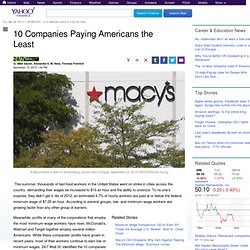
To no one’s surprise, they didn’t get it. As of 2012, an estimated 4.7% of hourly workers are paid at or below the federal minimum wage of $7.25 an hour. According to several groups, low- and minimum-wage workers are growing faster than any other group of earners. Meanwhile, profits at many of the corporations that employ the most minimum-wage workers have risen. McDonald’s, Walmart and Target together employ several million Americans. ALSO READ: Cities with the Widest Gap Between the Rich and Poor Click here to see the Ten Companies Paying Americans the Least Companies that pay employees poorly fall into one of three industries: retailers such as Walmart and Sears, restaurant chains such as McDonald’s and Yum!
ALSO READ: How Will Disney Handle the ABC and Jimmy Kimmel Protests? 10. Starbucks Corp. 9. The Conservative Argument For Raising The Minimum Wage. Let's turn our attention now to California.
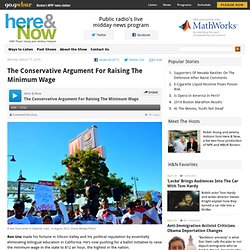
Who is one of the most passionate voices behind a push to raise that state's minimum wage to $12 an hour? He's a Silicon Valley millionaire and a libertarian and former publisher of the American Conservative magazine. Not the typical profile of a champion for higher wages, but Ron Unz is spending a lot of his own time and money to put a new minimum wage question before California voters. Ron Unz joins us from the studios of Stanford University, and Ron, welcome, and let's just start with the obvious question.
What first made you think that raising the minimum wage in California is a good idea? RON UNZ: Probably the thing that got me involved in the issue was actually the immigration question because it seemed to me that right now, with all the immigration issues America has, one of the arguments frequently made is that a lot of the immigrants who come here take the jobs that Americans don't want, and that's perfectly true. UNZ: I totally agree. Reducing inequality is first step to curbing poverty. Not long ago, reducing inequality of wealth and income was a mission reserved for political leftists, often condemned as no more than the politics of envy by their ideological rivals.
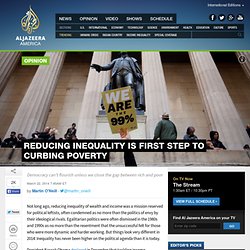
Egalitarian politics were often dismissed in the 1980s and 1990s as no more than the resentment that the unsuccessful felt for those who were more dynamic and harder working. But things look very different in 2014: Inequality has never been higher on the political agenda than it is today. President Barack Obama declared in December that tackling income inequality is “the defining challenge of our time.”
Bill de Blasio has begun his New York mayoralty by vowing to address the “quiet crisis” of inequality. And Pope Francis, in the first apostolic letter of his papacy, condemned inequality as “the root of social ills”, leading to a “moral destitution” that destroys the social fabric. Now that inequality is clearly no longer a marginal concern, what should we make of this upsurge of egalitarian rhetoric?